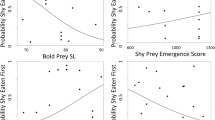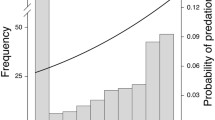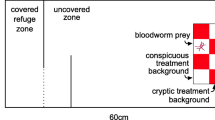Abstract
Although the existence of different personality traits within and between animal populations has been relatively well established, the ecological implications of this variation remain neglected. In this study we tested whether differences in the boldness of pairs of three-spined sticklebacks led to differential predation risk in their prey, Chironomidae larvae. Bolder pairs, those that left a refuge and crossed the tank mid-line sooner, ate a greater proportion of prey in 10 min than less bold fish (therefore prey were at a greater per capita risk). Fish crossed the mid-line more rapidly when a larger number of prey were presented, suggesting they accepted greater risk in return for a larger foraging reward. Perception of predation risk also affected the differences between fish in boldness, as larger fish crossed the mid-line sooner after leaving the refuge (larger fish are less at risk from predation). Hence, an interesting trophic interaction occurs, where the risk experienced by the chironomid larvae is determined by the risk perceived by their predators. Through the variation generated by boldness, a form of behaviourally mediated trophic cascade can occur within (as well as between) communities.



Similar content being viewed by others
References
Beckerman AP, Uriarte M, Schmitz OJ (1997) Experimental evidence for a behavior-mediated trophic cascade in a terrestrial food chain. PNAS 94(20):10735–10738
Both C, Dingemanse NJ, Drent PJ, Tinbergen JM (2005) Pairs of extreme personalities have highest reproductive success. J Anim Ecol 74:667–674
Botham MS, Kerfoot CJ, Louca V, Krause J (2006) The effects of different predator species on antipredator behavior in the Trinidadian guppy, Poecilia reticulata. Naturwissenschaften 93:431–439
Brown C, Jones F, Braithwaite V (2005) In situ examination of boldness–shyness traits in the tropical poeciliid, Brachyraphis episcopi. Anim Behav 70:1003–1009
Coleman K, Wilson DS (1998) Shyness and boldness in pumpkinseed sunfish: individual differences are context-specific. Anim Behav 56:927–936
Cresswell W (1994) Flocking is an effective anti-predation strategy in redshanks, Tringa totanus. Anim Behav 47:433–442
Dingemanse NJ, Both C, van Noordwijk AJ, Rutten AL, Drent PJ (2003) Natal dispersal and personalities in great tits (Parus major). Proc R Soc B 270:741–747
Dingemanse NJ, Both C, Drent PJ, Tinbergen JM (2004) Fitness consequences of avian personalities in a fluctuating environment. Proc R Soc B 271:847–852
FitzGibbon CD (1990) Mixed species grouping in Thomson and Grant gazelles—the anti-predatory benefits. Anim Behav 39:1116–1126
Fraser DF, Gilliam JF, Daley MJ, Le AN, Skalski GT (2001) Explaining leptokurtic movement distributions: intrapopulation variation in boldness and exploration. Am Nat 158:124–135
Genkai-Kato M (2007) Macrophyte refuges, prey behaviour and trophic interactions: consequences for lake water clarity. Ecol Lett 10(2):105–114
Godin J-GJ, Smith SA (1988) A fitness cost of foraging in the guppy. Nature 333:69–71
Hölker F, Steif P (2005) Adaptive behaviour of chironomid larvae (Chironomus riparius) in response to chemical stimuli from predators and resource density. Behav Ecol Sociobiol 58:256–263
Huang C, Sih A (1991) Experimental studies on direct and indirect interactions in a three trophic-level stream system. Oecologia 85:530–536
Hugie DM, Dill LM (1994) Fish and game—a game-theoretic approach to habitat selection by predators and prey. J Fish Biol 45:151–169
Ioannou CC, Krause J (2008) Searching for prey—the effect of group size and number. Anim Behav 75(4):1383–1388
Krause J, Ruxton GD (2002) Living in groups. Oxford University Press, Oxford
Krause J, Loader SP, McDermott J, Ruxton GD (1998) Refuge use by fish as a function of body length-related metabolic expenditure and predation risks. Proc R Soc B 265(1413):2373–2379
Lima SL (1998) Stress and decision making under the risk of predation: recent developments from behavioral, reproductive, and ecological perspectives. Adv Stud Behav 27:215–290
Lima SL (2002) Putting predators back into behavioural predator–prey interactions. Trends Ecol Evol 17:70–75
McGill BJ, Mittelbach GG (2006) An allometric vision and motion model to predict prey encounter rates. Evol Ecol Res 8:691–701
Réale D, Festa-Bianchet M (2003) Predator-induced selection on temperament in bighorn ewes. Anim Behav 65:463–470
Réale D, Gallant BY, LeBlanc M, Festa-Bianchet M (2000) Consistency of temperament in bighorn ewes and correlates with behaviour and life history. Anim Behav 60:589–597
Réale D, Reader SM, Sol D, McDougall PT, Dingemanse NJ (2007) Integrating animal temperament within ecology and evolution. Biol Rev 82(2):291–318
Sih A (1998) Game theory and predator–prey response races. In: Dugatkin LA, Reeve HK (eds) Advances in game theory and the study of animal behaviour. Oxford University Press, Oxford, pp 221–238
Sih A, Bell AM, Johnson JC (2004) Behavioral syndromes: an ecological and evolutionary overview. Trends Ecol Evol 19:372–378
Sogard SM (1997) Size-selective mortality in the juvenile stage of teleost fishes: a review. Bull Mar Sci 60:1129–1157
Turner GF, Pitcher J (1986) Attack abatement: a model for group protection by combined avoidance and dilution. Am Nat 128:228–240
Ward AJW, Thomas P, Hart PJB, Krause J (2004) Correlates of boldness in three-spined sticklebacks (Gasterosteus aculeatus). Behav Ecol Sociobiol 55:561–568
Wilson DS, Clark AB, Coleman K, Dearstyne T (1994) Shyness and boldness in humans and other animals. Trends Ecol Evol 9:442–446
Acknowledgements
Thanks to Amy Wade, Ben Chapman, Colin R. Tosh, Libby Marschall and an anonymous reviewer for helpful comments which improved the manuscript invaluably. C. C. Ioannou is supported by a Leeds University Research Scholarship and J. Krause by a NERC grant. This study complies with UK law on animal experimentation.
Author information
Authors and Affiliations
Corresponding author
Additional information
Communicated by Libby Marschall.
Rights and permissions
About this article
Cite this article
Ioannou, C.C., Payne, M. & Krause, J. Ecological consequences of the bold–shy continuum: the effect of predator boldness on prey risk. Oecologia 157, 177–182 (2008). https://doi.org/10.1007/s00442-008-1058-2
Received:
Accepted:
Published:
Issue Date:
DOI: https://doi.org/10.1007/s00442-008-1058-2




